As the DDR4 SDRAM standard becomes more familiar and mature, enthusiast memory manufacturers are mastering the release of faster and faster memory modules. On the one hand, this is facilitated by the improvement of technical processes, on the other, by the emergence of more malleable DDR4 chips in terms of operating parameters, and on the third, by a request from users who have learned well that memory speed can seriously affect system performance. Therefore, now, on the verge of the appearance of mass systems with support for DDR5 SDRAM, the DDR4 memory market offers countless options that differ in frequency, timings, external design and, of course, in price. The choice in such conditions becomes far from easy, and many simply buy the memory of their favorite brand. However, the most popular memory of famous manufacturers, for example brands like Kingston or G.Skill, may not be the best choice. Interesting options can be found among the products of many other companies.
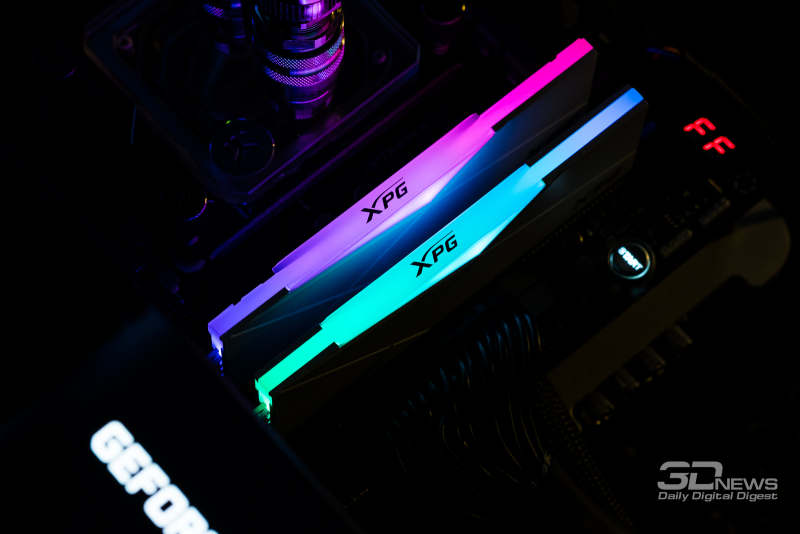
To illustrate this with an illustrative example, in this review we take a look at the ADATA product that it offers in the XPG (eXtreme Performance Gear) series for gamers and enthusiasts. We are talking about the XPG Spectrix D50 kit, which claims to be one of the most beloved DDR4 memory enthusiasts. At least the XPG Spectrix D50 modules have a nice uncomplicated design, they are equipped with discreet and soft RGB-illumination, their specifications are comparable to those of the proposals of recognized leaders, and, most importantly, all this is offered at an affordable price, which is a business card ADATA.
More specifically, we will talk about XPG Spectrix D50 DDR4-4133 2 × 8 GB memory. And right away it should be said that this is one of the most affordable kits among offerings with a frequency above 4000 MHz, but at the same time it is based on the legendary Samsung B-die chips, which are famous for their unsurpassed flexibility and excellent overclockability.
⇡ # Specification and delivery set
The XPG Spectrix D50 DDR4-4133 2 × 8 GB memory kit we received for tests has the part number AX4U413338G19J-DW50, and this is a set of two modules with white heat sinks. In assortment ADATA there is the same product with unpainted aluminum radiators, its article number is AX4U413338G19J-DT50, and it is no different except for color. Therefore, everything that will be said later in this article can equally be attributed to both the AX4U413338G19J-DW50 kit and the AX4U413338G19J-DT50.

The labeling of the modules obviously contains information not only about the color of the heatsinks, but also about the memory speed and CAS Latency, but, unfortunately, it does not describe the hardware in any way – the type of microcircuits used in the modules. The kit that we got for testing was based on Samsung B-die chips. but not fixed anywherethat such microcircuits will always be used in the memory in question, and this leaves ADATA room for manipulation. At some point, instead of Samsung B-die chips, some other microcircuits may appear in the XPG Spectrix D50 DDR4-4133 2 × 8 GB memory sticks. And in this case, the attractiveness of the set in question will change greatly.

The full formal characteristics are as follows:
- memory size: a set of modules with a volume of 16 GB (two modules of 8 GB each);
- operating frequency: DDR4-4133;
- timings: 19-23-23-45 (programmed in XMP);
- operating voltage: 1,4 V;
- highly efficient configurable RGB backlit heat dissipators;
- XMP 2.0 support;
- lifetime warranty.
The characteristics of the XPG Spectrix D50 DDR4-4133 2 × 8 GB kit seem to have been specially formulated with an eye to the fact that both Micron and SK Hynix chips can be installed in them. The possibility of substitution directly follows from the very liberal timing scheme and from the fact that in the specifications tRCD and tRP timings are significantly superior to CAS Latency. In other words, with the XPG Spectrix D50 DDR4-4133 2 × 8 GB kit, you need to keep your eyes open.
Against this background, it seems quite natural that ADATA does not indicate for its memory any platforms recommended for its use, nor a list of motherboards with which the kit in question was tested. In this sense, the support from the manufacturer is clearly lame. But let’s add that such memory is more likely focused on the Intel platform. AMD processors do not support memory operation faster than DDR4-3800 in synchronous mode, and therefore it makes no practical sense to choose DDR4-4 for Socket AM4133 systems – expensive high-speed modules will not give the expected performance gain.
The package for the XPG Spectrix D50 memory is completely normal – the buyer gets two modules at his disposal and nothing else. Even the installation instructions are printed on the inside of the box. However, this is not surprising – memory manufacturers very rarely supplement their products with some kind of accessories.
The cost of the AX4U413338G19J-DW50 kit in Russian stores is about 10 thousand rubles. This is about 20% more expensive than the average DDR4-3600 SDRAM of the same size, which, taking into account the characteristics and Samsung B-die chips, makes the ADATA offer attractive.
⇡ # Appearance
ADATA offers a large selection of overclocking memory, but XPG Spectrix D50 modules look among the many brothers, perhaps the most interesting of all. On the one hand, they have massive heatsinks and RGB backlighting, and on the other hand, with the use of shapes, colors and design techniques, there are no excesses – the modules look very neat and do not draw attention to themselves in the assembled system, which will allow them to fit into assembly of almost any style.
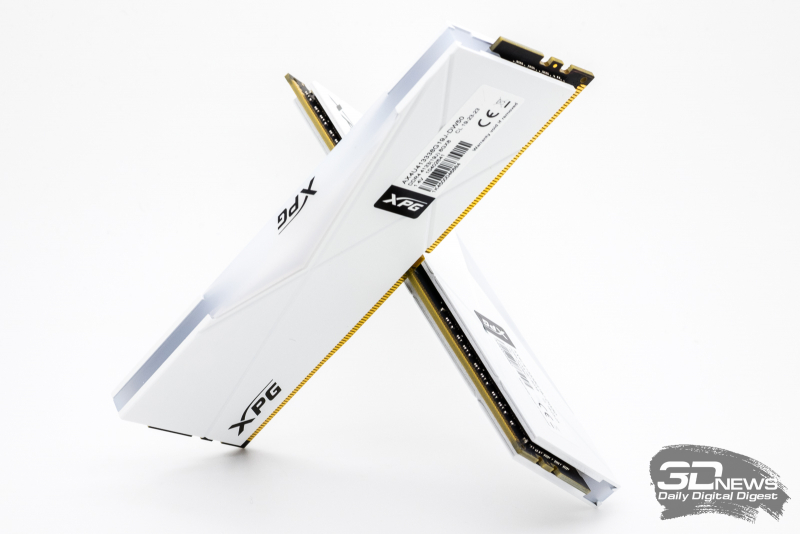
Both sides of each module are covered with massive flat aluminum plates, painted in our case with white paint. A translucent plastic insert is clamped between them from above, illuminated from the inside by RGB LEDs. The whole composition is enlivened by three grooves that cut each heat dissipating plate, and a V-shaped cutout in their upper part, which is also filled with a luminous plastic insert.
The modules have black XPG logos on each side, in addition, each module has a sticker with markings and the main characteristics of the memory.

Illumination in XPG Spectrix D50 modules is controllable. Each module has a line of RGB LEDs along the top edge, the algorithms of joint work of which can be arbitrarily changed. By default, the modules are cyclically iridescent in all possible colors, but the manufacturer promises backlight compatibility with the systems of all major motherboard manufacturers and support for a wide variety of modes.
Also ADATA has its own utility for managing RGB memory modes – XMP RGB Sync App.
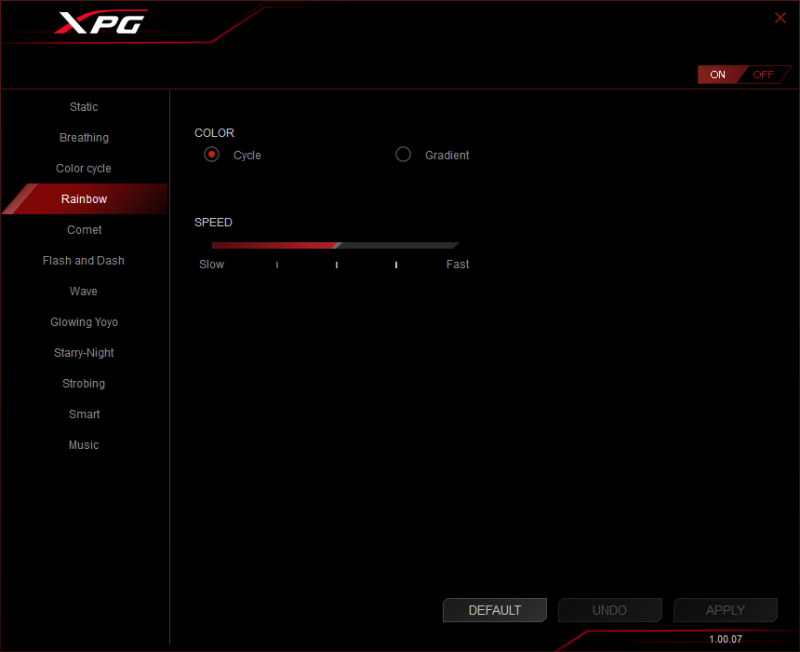
Speaking about the exterior, one cannot fail to mention that the XPG Spectrix D50 modules turned out to be quite massive and oversized. Their height reaches 45 mm, and this can become a problem when used with some especially large air processor coolers. However, 45 mm is almost the standard height for overclocking modules, for example, the popular G.Skill Trident Z memory has exactly the same height.
⇡ # Internal structure and features of work
Included XPG Spectrix D50 DDR4-4133 2x8GB memory modules – single-sided and peer-to-peer. Each module contains eight chips with a capacity of 8 Gbit. In our case, these chips are Samsung K4A8G085WB-BCPB, known to all enthusiasts as B-die.
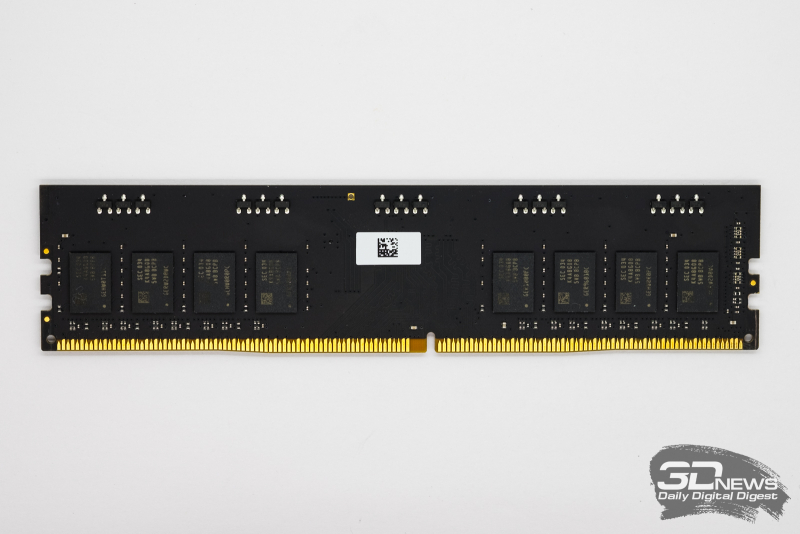
As you can see from the photo, ADATA uses its own PCB, designed based on the standard version A2 board. The design changes had to be made due to the LED backlighting. It is implemented in the XPG Spectrix D50 by ten LEDs located on the back (relative to the chips) side of the printed circuit board. Due to the rather small intervals between the LEDs, the effect of uniformity of illumination is achieved – individual light spots are completely invisible through the light-scattering insert.
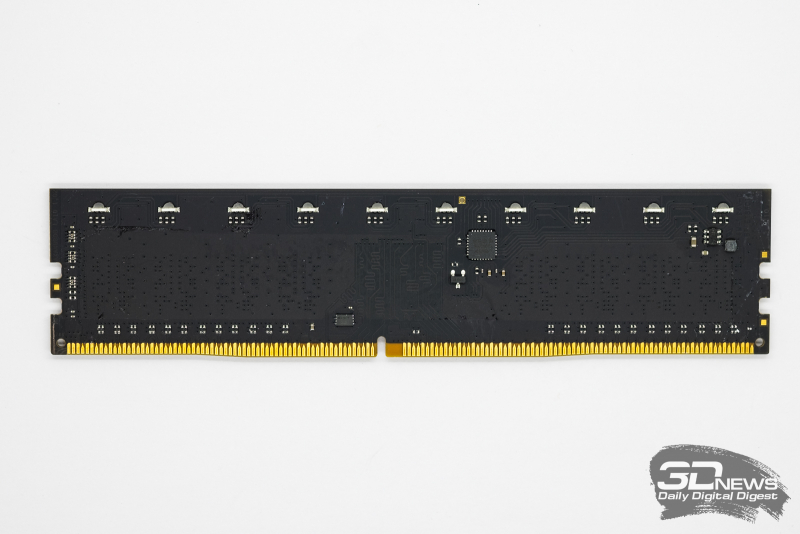
But on the built-in thermal sensor in the XPG Spectrix D50 modules, they saved. It will not be possible to track the temperature regime of the memory using standard hardware monitoring tools. However, it is hardly worth worrying about the heating of the modules under consideration – the heat dissipating plates look very solid both due to their area and due to the 2,5 mm thickness.
The Samsung B-die memory chips used as part of the XPG Spectrix D50 DDR4-4133 2 × 8 GB kit are formally designed to work in DDR4-2133 mode with 15-15-15 timings, but they are superbly overclocked with increasing supply voltage. Accordingly, the secret of the high frequency of the modules under consideration lies both in the selection of successful microcircuits and in the fact that the supply voltage of 1,4 V is determined for this memory (and the usual voltage for DDR4 memory is 1,2 V).
The nominal mode for the considered set AX4U413338G19J-DW50 is DDR4-4133 with latencies 19-23-23-45, it is wired into one of the XMP profiles. In addition, XMP also has an alternative profile for DDR4-4000 mode with timings 18-19-19-39, and the voltage is declared for it not 1,4, but 1,35 V. Probably ADATA prepared it for those cases when the faster DDR4-4133 mode will not be able to pull the memory controller of a particular processor.
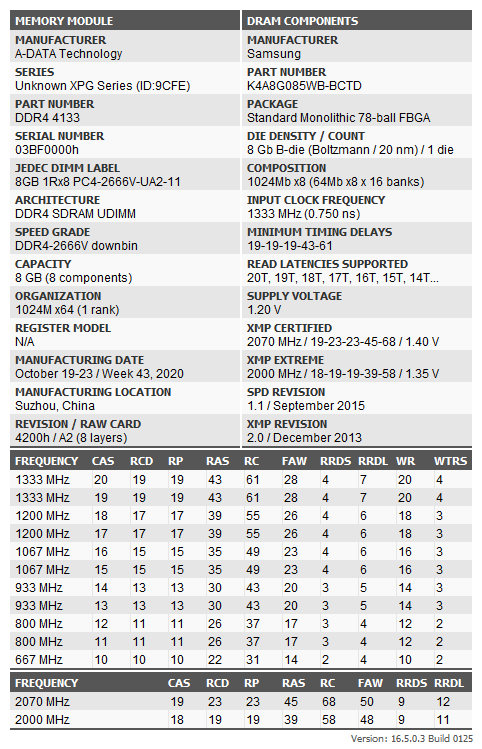
The performance of the XPG Spectrix D50 DDR4-4133 2 × 8 GB kit when configured using the profiles saved in XMP is shown in the screenshots below.
Result on AMD platform (with Ryzen 7 5800X processor):
 |
 |
Result on Intel platform (with Core i7-10700K processor):
 |
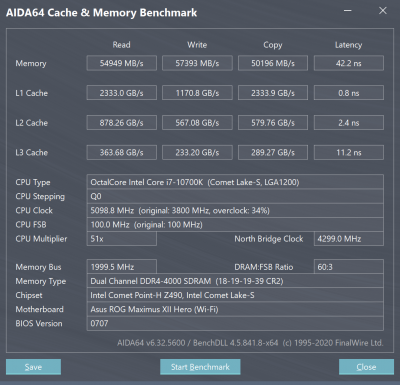 |
Judging by the results, the DDR4-4000 mode can be even more beneficial, although the differences in the practical performance of the memory subsystem in both configuration options are minimal.
⇡ # Description of the test system
We tested the AX4U413338G19J-DW50 memory kit on two test systems based on the Ryzen 7 5800X and Core i7-10700K processors. Using two platforms at once will make it possible to conclude in which cases such memory is better suited. On the one hand, it is believed that speed kits are focused more on Intel processors. But on the other hand, the memory in question is based on Samsung B-die chips, which means its flexibility and omnivorousness.
To make the performance that can be obtained with XPG Spectrix D50 DDR4-4133 2x8GB modules more visually appealing, we also tested reference memory – the popular inexpensive Crucial Ballistix DDR4-3200 2x8GB kit (BL2K8G32C16U4R ) on Micron Rev. E, which was tested with settings according to the XMP profile (16-18-18-36).
Thus, test systems were assembled from the following set of equipment:
- Processors:
- AMD Ryzen 7 5800X (Vermeer, 8 cores + SMT, 3,8-4,7 GHz, 32 MB L3);
- Intel Core i7-10700K (Comet Lake, 8 cores + HT, 3,8-5,1 GHz, 16 MB L3).
- CPU cooler: Noctua NH-D15S.
- Motherboards:
- ASUS ROG Crosshair VIII Hero (Socket AM4, AMD X570);
- ASUS ROG Maximus XII Hero (Wi-Fi) (LGA 1200, Intel Z490).
- Memory:
- ADATA XPG Spectrix D50 DDR4-4133 2 × 8 GB (AX4U413338G19J-DW50);
- Crucial Ballistix DDR4-3200 2x8GB (BL2K8G32C16U4R).
- Video card: NVIDIA GeForce RTX 3090 Founders Edition (GA102, 1400-1700 / 19500 MHz, 24 GB GDDR6X 384-bit).
- Disk subsystem: Samsung 970 EVO Plus 2TB (MZ-V7S2T0BW).
- Power supply: Thermaltake Toughpower DPS G RGB 1000W Titanium (80 Plus Titanium, 1000W).
Testing was performed on Microsoft Windows 10 Pro 20H2 Build 19042.572 using the following set of drivers:
- AMD Chipset Driver 2.10.13.408;
- NVIDIA GeForce 461.09 Driver.
Description of the tools used to measure computational performance:
Synthetic benchmarks:
- AIDA64 Engineer 6.32.5600 – Cache and Memory Benchmark.
Applications:
- 7-zip 19.00 – testing the speed of archiving. The time taken by the archiver to compress a directory with various files with a total volume of 3,1 GB is measured. The LZMA2 algorithm and the maximum compression ratio are used.
- Adobe Photoshop Lightroom Classic 9.3 – performance testing when batch processing a series of images in RAW format. The test scenario includes post-processing and JPEG export at 1920 × 1080 resolution and maximum quality of two hundred 16MP RAW images taken with a Fujifilm X-T1 digital camera.
- Magix Vegas Pro 18.0 – performance testing for non-linear video editing. This measures the render time to YouTube 4K of a project containing HDV 2160p30 footage with various effects applied.
Games:
- Cyberpunk 2077. Resolution 1920 × 1080: Quick Preset = Ray Tracing – Ultra.
- Shadow of the Tomb Raider. 1920 × 1080 resolution: DirectX12, Preset = Highest, Anti-Aliasing = TAA.
- A Total War Saga: Troy. 1920 × 1080 resolution: DirectX 12, Quality = Ultra, Unit Size = Extreme.
In all gaming tests, the results are the average number of frames per second, as well as the 0,01-quantile (first percentile) for the FPS values. The use of 0,01-quantile instead of the minimum FPS indicators is due to the desire to clear the results from random performance spikes that were provoked by reasons not directly related to the operation of the main platform components.
⇡ # Overclocking
Configuring the XPG Spectrix D50 DDR4-4133 2x8GB memory kit by activating settings from XMP is clearly not the best approach. In systems based on AMD processors, there is no point in using memory at a frequency higher than 3733-3800 MHz, because this switches the system to asynchronous mode with the memory controller and the Infinity Fabric bus. Therefore, the DDR4-4133 mode is contraindicated in such cases.
If we talk about systems based on Intel processors, then DDR4-4133 SDRAM may be appropriate in them, but the standard timing scheme 19-23-23-45 raises very big questions. The memory based on Samsung B-die chips is clearly capable of more. The tRCD and tRP values look especially ridiculous – the giant timings that are programmed into XMP are clearly far from common sense. In other words, using the XPG Spectrix D50 DDR4-4133 2 × 8 GB kit with standard XMP settings is a bad idea anyway, and this memory is in dire need of manual configuration. Let’s check what is achieved in this case.
⇡#AMD: DDR4-3800 15-15-14-32
In AMD platform, high-speed memory should be operated in DDR4-3800 or DDR4-3733 modes (depending on the ability of a particular processor to operate at 1866 or 1900 MHz Infinity Fabric frequency). In our experiments, the XPG Spectrix D50 DDR4-4133 2 × 8 GB kit was able to work stably as DDR4-3800 with 15-15-14-32 timings at 1,4 V, which is the passport for the AX4U413338G19J-DW50 kit.

Compared to the XMP settings mode, the performance gain is simply gigantic. Practical latency drops by 23%, and real throughput turns out to be higher than offered by ADATA settings by 18%. It turns out that the XPG Spectrix D50 DDR4-4133 2 × 8 GB memory is quite suitable for Ryzen processors, but only if you are not too lazy to configure it in a completely manual mode.
⇡#Intel: DDR4-4133 17-17-17-35
When installing the AX4U413338G19J-DW50 kit into the Intel platform and choosing the standard DDR4-4133 frequency for it, the timings can be dramatically improved. With a nominal voltage of 1,4 V, the nominal timings 19-23-23-45 are easily optimized to 17-17-17-35. The performance gain of the memory subsystem is not long in coming.
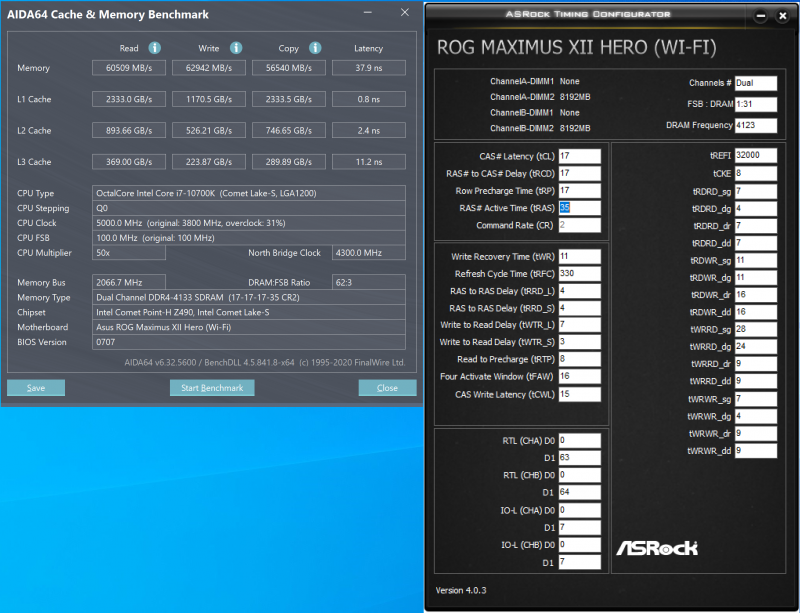
The screenshot shows that the optimization of the settings made it possible to reduce the practical latency by 14% and increase the practical bandwidth by 12%. This achievement clearly shows how negligent ADATA is approached the question of creating suitable XMP profiles for our own memory. Timing scheme offered by ADATA, can only be explained by the assumption that this is a kind of uniform and universal profile used by the manufacturer for memory modules of fundamentally different types.
⇡#Intel: DDR4-4266 19-18-18-35
As the experiment showed, the AX4U413338G19J-DW50 kit in the Intel system can be additionally overclocked in frequency. By raising the voltage to 1,45 V, we managed to achieve its stable operation in DDR4-4266 mode. True, this required significantly weakening the delays, reaching the 19-18-18-35 scheme. Nevertheless, practical measurements in the AIDA64 Cache and Memory Benchmark show quite good performance indicators for the memory subsystem configured in this way.

Naturally, this configuration option noticeably outperforms the settings wired into the XMP profile. But not only. The read, write and copy throughput is even better than in the DDR4-4133 mode with optimized timings, but some loss manifests itself in latency. In other words, it is possible to additionally overclock the XPG Spectrix D50 DDR4-4133 2 × 8 GB kit in frequency, but there is no particular sense in this. It opens up quite well in DDR4-4133 mode.
⇡#Intel: DDR4-3466 14-14-14-28
Memory on Samsung B-die chips is always versatile. On the one hand, it can operate at relatively high frequencies, and on the other hand, at lower frequencies, it can be set to aggressive delays. Therefore, in some cases, high-speed kits like the XPG Spectrix D50 DDR4-4133 2 × 8 GB give better results if they are overclocked in a different direction – with an eye on minimizing timings rather than maximizing the frequency. For example, the memory kit under consideration turned out to be able to cope with the 14-14-14-28 delays in the DDR4-3466 mode (when obtaining this result, the nominal voltage of 1,4 V was used).
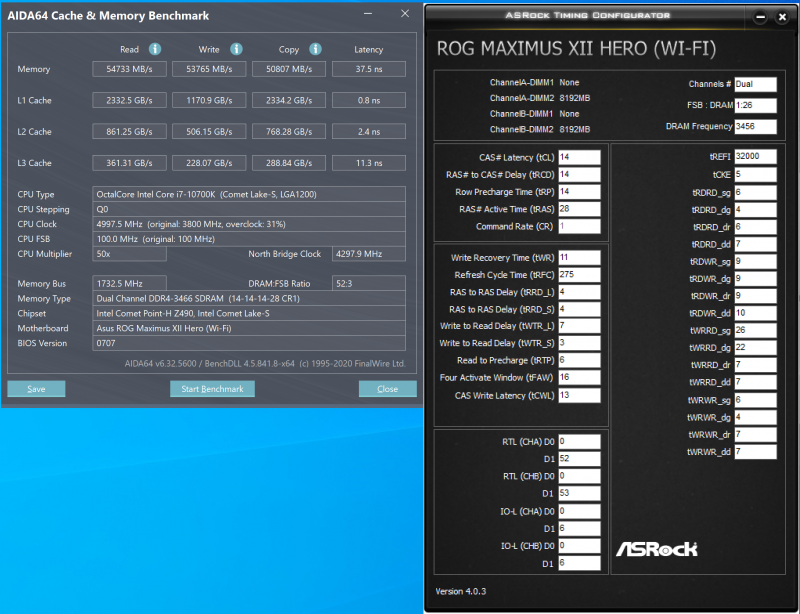
In this case, you can reduce not only the base latency, but also many secondary and tertiary timings. But in terms of the final performance of the memory subsystem, this mode still turned out to be slightly worse than the DDR4-4133 17-17-17-35 version. Practical latency, according to the AIDA64 Cache and Memory Benchmark, is almost the same here, but the performance of reading, writing and copying data is noticeably lower. This means that the most promising overclocking option for the AX4U413338G19J-DW50 kit in the Intel platform is to optimize the delays at its passport frequency DDR4-4133.
⇡ # AMD platform performance
On a Ryzen 7 5800X based platform, we compared three memory configuration options: when the Crucial Ballistix DDR4-3200 2x8GB kit is installed in the system with its default settings, when the ADATA kit is installed XPG Spectrix D50 DDR4-4133 2x8GB with settings from XMP main profile and when ADATA kit XPG Spectrix D50 is used in DDR4-3800 mode with manually selected timings.
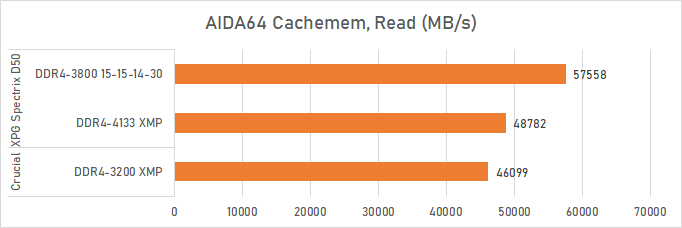
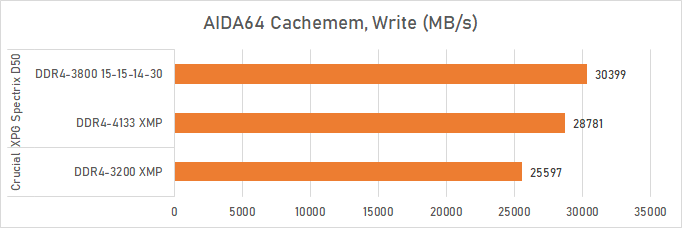
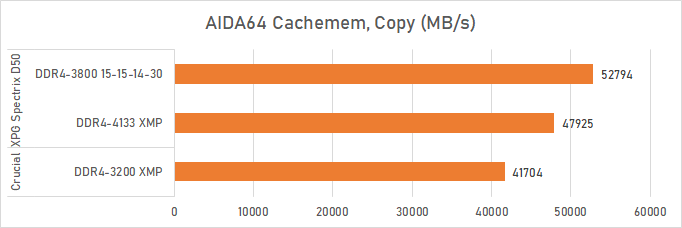
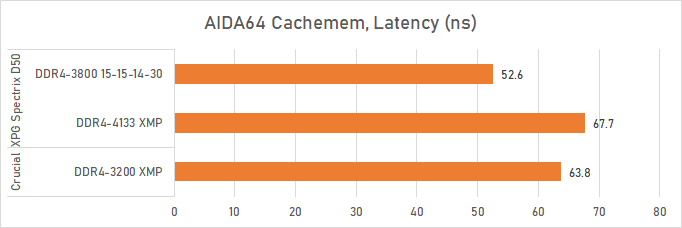
The very first measurement made in the AIDA64 Cache and Memory Benchmark confirms that the nominal mode of the ADATA kit The XPG Spectrix D50 DDR4-4133 2x8GB on a Ryzen processor doesn’t make sense. Due to the fact that high memory frequencies in such systems are possible only with the asynchronous operation of the Infinity Fabric bus and the memory controller, there is a rather noticeable speed penalty. As a result, even a primitive DDR4-3200 kit is capable of providing a higher performance of the memory subsystem than overclocking DDR4 SDRAM operating in DDR4-4133 mode. But the same ADATA kit when switched to DDR4-3800 mode, which is achievable with synchronous clocking of the Infinity Fabric, it can be very efficient. However, it is not the 3800 MHz frequency itself that helps to a large extent, but the manual adjustment of the timings, which, in the case of the XPG Spectrix D50 kit based on Samsung B-die chips, works wonders.
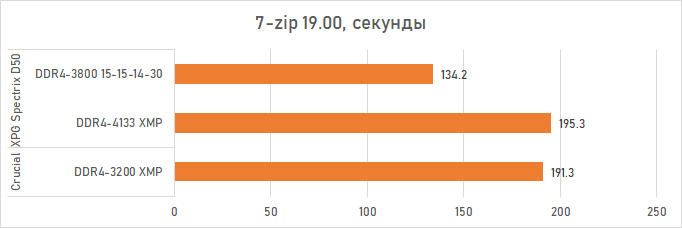
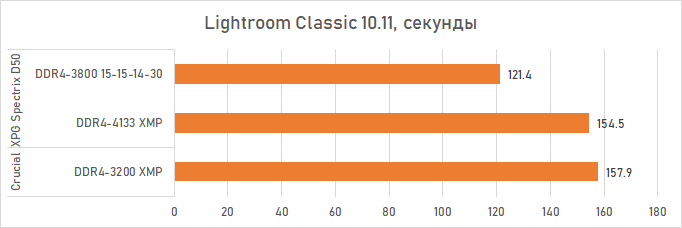
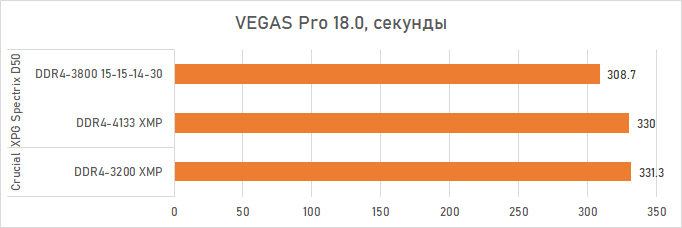
The Advantage You Can Get With the ADATA Kit XPG Spectrix D50 DDR4-4133 2 × 8 GB in DDR4-3800 mode will inevitably translate into increased application performance. And in some of them (especially seriously tied to memory – such as, for example, archiving), the performance gain can be truly phenomenal.
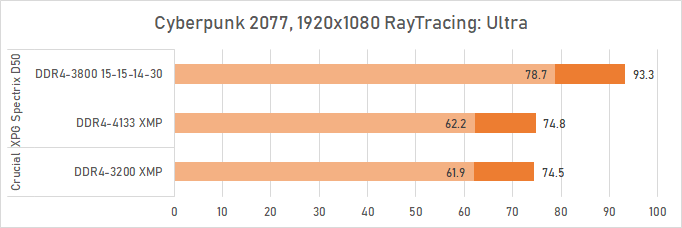
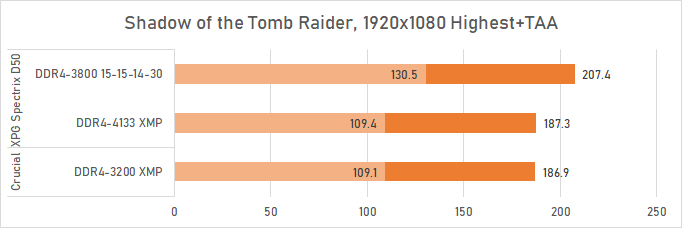
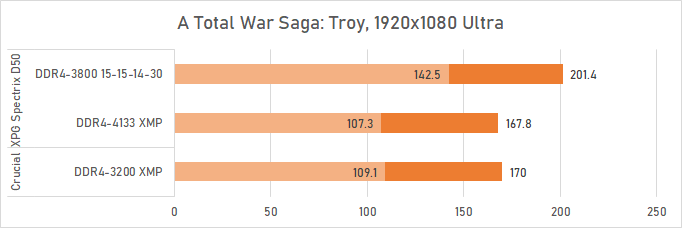
Optimizing memory settings significantly speeds up games. ADATA The XPG Spectrix D50 DDR4-4133 2x8GB in DDR4-3800 mode offers a frame rate advantage of up to 25% when compared to the “regular” DDR4-3200 kit. For the sake of such an increase, it should not be a pity to spend extra money on high-quality memory modules. But once again, we note that the use of XPG Spectrix D50 memory with XMP settings without any optimization, it is not at all better to use the mainstream DDR4-3200 modules. This means that ADATA overclocking memory Skillful overclocking hands must be included.
⇡ # Performance in the Intel platform
On a platform based on a Core i7-10700K processor, the ADATA kit The XPG Spectrix D50 DDR4-4133 2 × 8 GB required more detailed testing. The fact is that, in addition to the passport mode with the settings from the XMP profile, you need to check three more memory subsystem configuration options that correspond to different approaches to overclocking: DDR4-3466 with aggressive timings, DDR4-4133 with minimized timings and the maximum frequency mode DDR4-4266 …
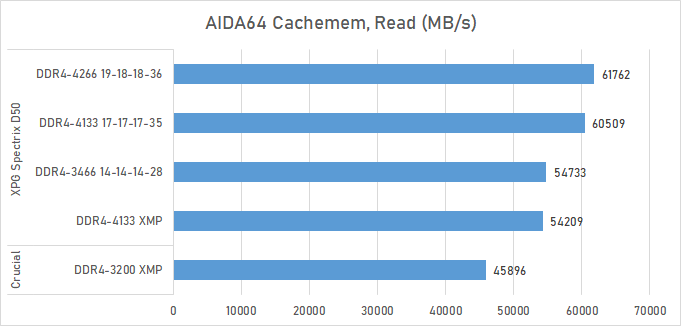

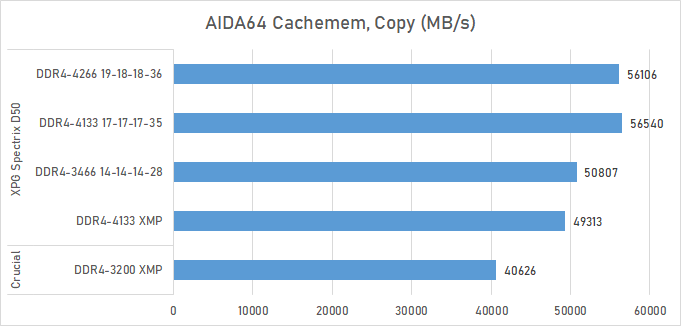

The result of the AIDA64 Cache and Memory Benchmark is somewhat similar to the picture we saw in the AMD platform. All modes in which the latency was manually adjusted turned out to be significantly better than the configuration option proposed by ADATA in your XMP profile. And it is very significant that even the DDR4-3466 mode with the correct manual settings allows you to get about the same practical read and write speed as the XMP profile, which uses a 20% higher memory frequency. And one more curious observation: the practical latencies in manually configured modes DDR4-3466, DDR4-4133 and DDR4-4266, against the background of noticeable differences in bandwidth, turn out to be approximately equal.
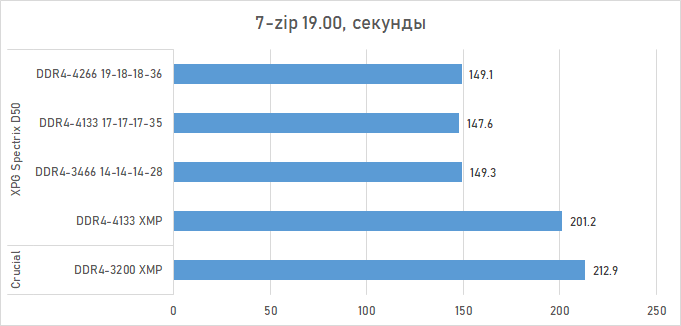


The huge gap in the memory subsystem speed shown in the diagrams above is naturally reflected in the performance of applications working with large amounts of data. ADATA memory kit XPG Spectrix D50 DDR4-4133 2×8 GB with tuned timings will allow you to win up to 30-40% performance when compared to the “regular” DDR4-3200, working with the default settings taken from XMP.
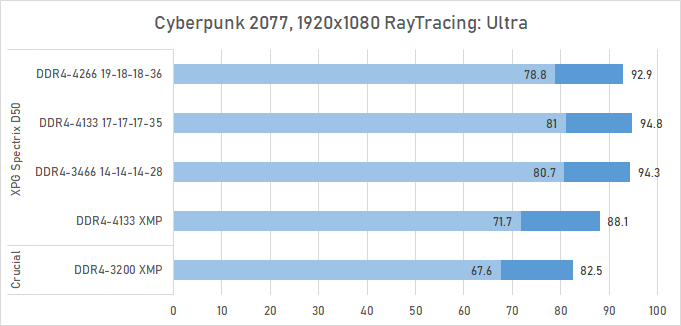
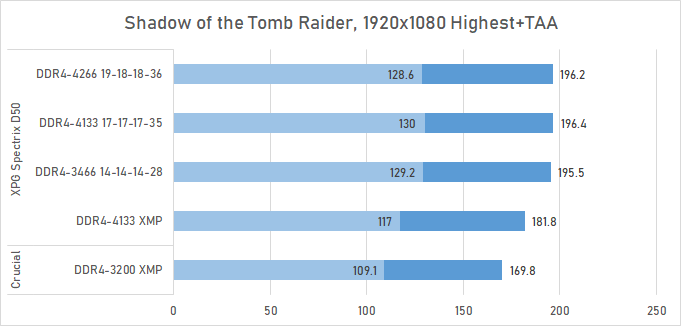
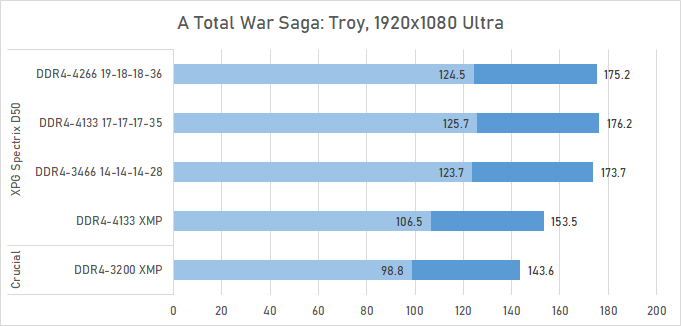
Fast memory is not useful in all content processing applications. But 3D games are usually very responsive to the speed of the memory subsystem. This is also shown by the results of comparison of XPG Spectrix D50 DDR4-4133 2 × 8 GB with DDR4-3200 modules. The use of overclocking memory, even without special settings, raises the frame rate by 6-7%. And if you spend time optimizing latency, you can achieve much more – in this case, the advantage in FPS can be up to 20%.
⇡ # Temperature mode
It was said above that the cooling system on XPG Spectrix D50 modules seems to be very effective. This statement was also made on the basis of practical experience. Despite the fact that for its AX4U413338G19J-DW50 kit, ADATA set the operating voltage increased to 1,4 V, they heat up very moderately. Massive heat dissipation plates, which I did not skimp on ADATA, do an excellent job with their main function.
Unfortunately, XPG Spectrix D50 modules do not have thermal sensors, but you can quantify their heating using the thermal image below.

The temperature of the outer side of the heatsinks during the stability test in TestMem5 in DDR4-4133 17-17-17-35 mode does not rise above 45 degrees, and this is a very decent result.
⇡ # Conclusions
Tested ADATA Kit XPG Spectrix D50 DDR4-4133 2 × 8 GB leaves a favorable impression. Despite the fact that its nominal timings look too high, it offers ample opportunities for overclocking and optimizing settings. Ultimately, we can say that such memory should not be used at all in the passport mode embedded in XMP – it must be configured manually, and in this case its capabilities are fully revealed.
Tests have shown that the ADATA kit XPG Spectrix D50 DDR4-4133 2 × 8 GB can be used with equal success both in DDR4-4133 mode with 17-17-17-34 timings, and in DDR4-3466 mode with 14-14-14-28 timings. This memory is perfect for systems built on AMD processors – for them it can offer DDR4-3800 mode with 15-15-15-32 timings.
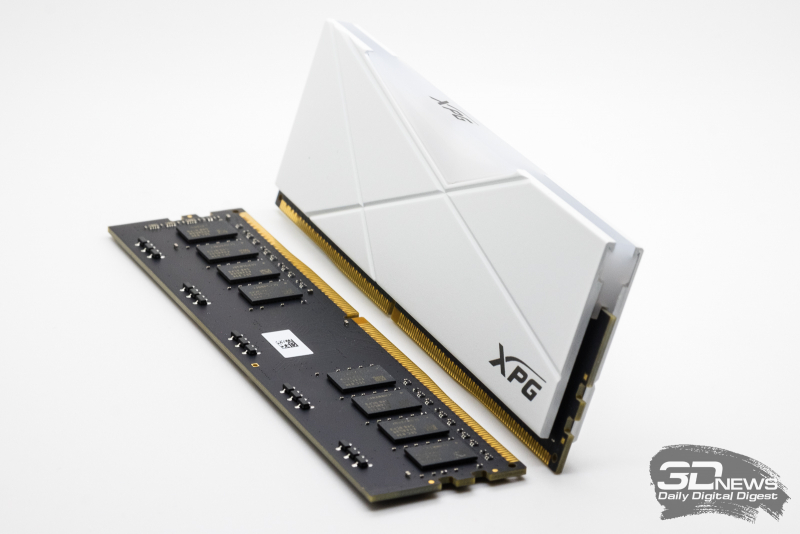
The XPG Spectrix D50 memory also has other advantages, such as a neutral appearance combined with RGB backlighting, as well as efficient cooling. It is rather strange that ADATA for some reason refused to implement temperature monitoring in its modules, which would be more than appropriate in them, given the wide overclocking capabilities of the considered set. But this disadvantage to ADATA modules It is quite possible to forgive, especially if we accept that this was done for the sake of reasonable savings, because you can buy AX4U413338G19J-DW50 memory at a very affordable price, despite the fact that these are by no means consumer goods, but high-speed DDR4-4133 modules.
However, a very important caveat must be made. All the brilliant results that the ADATA memory kit showed in tests XPG Spectrix D50 DDR4-4133 2 × 8 GB, due to the fact that it uses high-quality Samsung B-die chips. At the same time, ADATA does not guarantee that the same chips will always be used in the considered memory, because its specification is drawn up in such a way that it easily allows replacing the element base with microcircuits from other manufacturers. Moreover, it seems that this is already happening. Since the beginning of the year, there have been more than a few complaints from customers on the Web who got the AX4U413338G19J-DW50 memory kits with SK Hynix chips. And this is a much worse option in terms of overclocking and optimization capabilities.
Therefore, in conclusion, we consider it necessary to note once again that everything said above applies exclusively to the version of the AX4U413338G19J-DW50 kit with Samsung B-die chips, but this is not the only possible option.
If you notice an error, select it with the mouse and press CTRL + ENTER.




